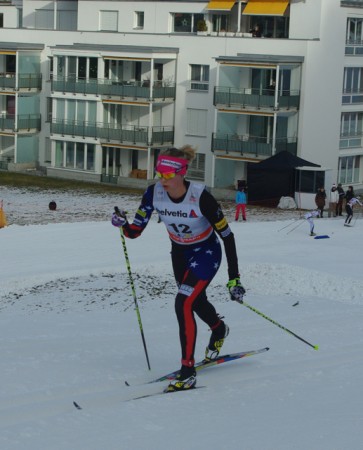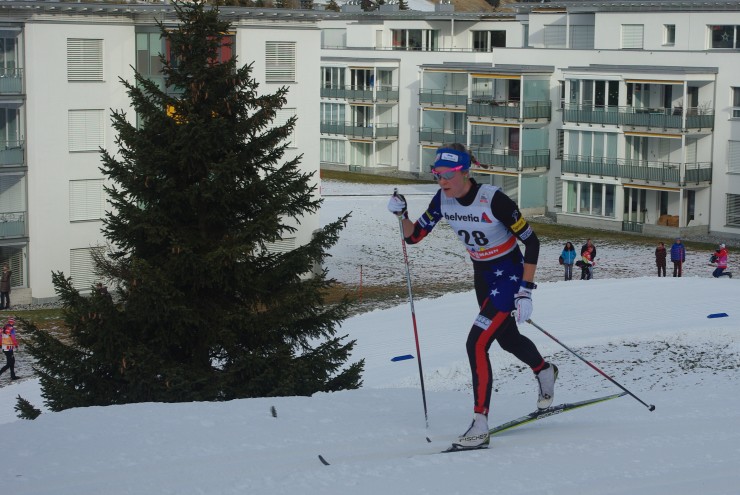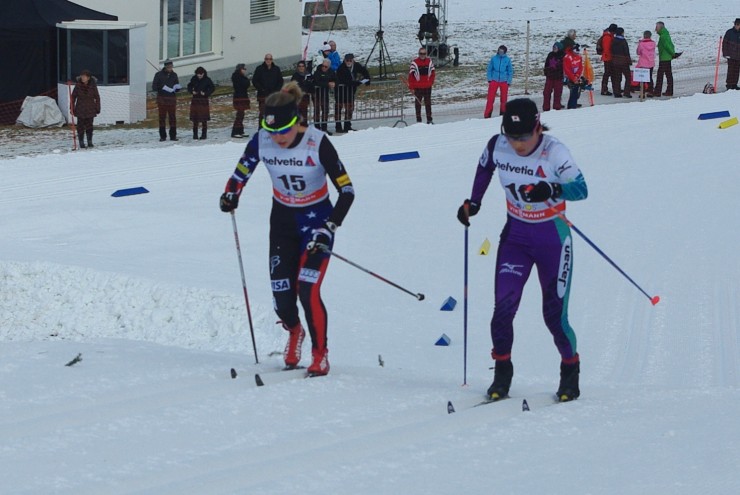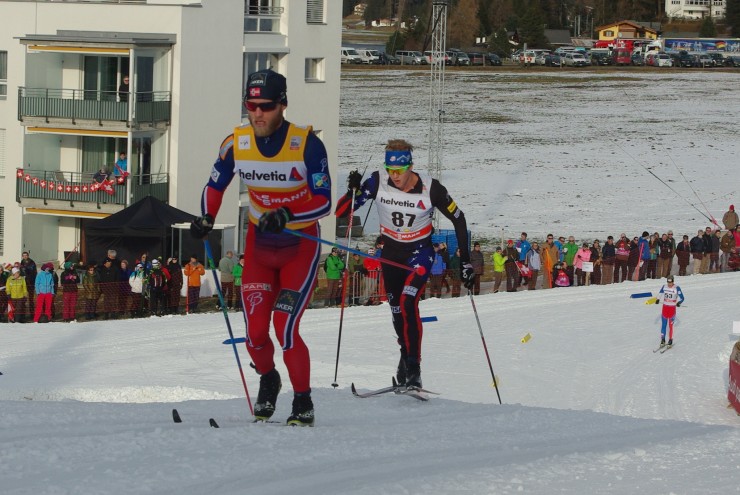
DAVOS, Switzerland— Sometimes, Liz Stephen says, you just gotta want the win.
The U.S. Ski Team veteran has spent several years on the World Cup circuit, competed in two Olympics, and tallied a few top-ten finishes. But this year, she’s focusing on channeling the hunger and aggression that you might have when you’re battling for a podium – every day, not just when she gets there.
“Last weekend, the battle between [Marit] Bjørgen and [Therese] Johaug at the end of that final climb, it’s just been replaying in my mind every single hour of the day since I saw it,” she said at the finish of today’s 10 k classic interval start. “So I was focused on that aggression, and trying to make skiing really, really matter, and wanting to win more than I’ve ever wanted to win. That’s what I’m trying to focus on more. I think you really have to want to win.”
Stephen didn’t win today, but she did finish 20th, a season best so far and matching her goal of getting in the top 20. She was the first of a bevvy of U.S. women right around that mark: Jessie Diggins was 4.8 seconds behind in 21st, and Sadie Bjornsen less than another second back in 22nd.
Three in the Low Twenties

Stephen has been coming to the World Cup in Davos since 2007, and only once has she had a better finish: two seasons ago, when it was a 10 k skate and she placed 15th. Skating is traditionally her better technique, and last year in a 15 k skate here she placed 20th.
With so many years of experience on the course, she knows that it’s not cut out to probably give her career-best results. But she wasn’t thinking about it that way when she hit the start today.
“This is a challenging course for me, but I wanted to look at it like, it’s a challenge, but not like, oh, it’s too hard and it’s not my type of course, I’m not going to do well,” she explained. “I came into it really positively. I had sections and words I was saying to myself in the different sections.”
In particular, she focused on downhills, which have challenged her so far this season.
“Last week’s downhills were quite terrifying for me, and I think I psyched myself out,” she admitted. “The real challenge for me this year is the downhills. For whatever reason, each year it gets worse. I did get stuck behind someone who was snowplowing, but that’s okay, people have been stuck behind me before.”
In terms of her goal of bringing the aggression, she felt like she succeeded, and was actually happy that the race was interval-start even though many of those psych-up images conjure mass start battles.
“At the end of the season we tend to have no individual starts, it’s like all mass,” she said. “And in the beginning it’s opposite. But I actually think it’s a good way to start, because if you can find it in the individual start, you can definitely find it in the mass start. For me today… I could use those cue words, I could use that focus I was trying to bring, how can I ski this section best. No-one’s in my way, this is all about me.”

Diggins was also trying to focus on specific sections of the course and work on her technique. Every previous time she’s raced the distance course in Davos, she has “blown up.” Today, she didn’t, which she considered an accomplishment, even if she still didn’t nail things perfectly.
“I tried to go so slow on the first lap and make sure that I could really work the sections I wanted to work,” Diggins said. “So I am really good at the flats and gradual downhills, being from the Midwest. I love gliding. So I know, ok, if I can save enough energy to really work that double pole and glide, that will really help me. So I tried to stay really calm on the uphill and just not stress, and chill.”
In the end she thought she could have brought a little more heat on the first lap, but was pleased with the overall result. She has been working hard on her classic technique, and thought she so progress with today’s race.
“My problem is that as I get tired, my stomach cramps and I fold [at the waist],” Diggins explained. “As soon as you do that you can’t kick, so it’s like, as I get tired it’s harder and harder to maintain that technique. In skate I’ve figured out how to keep going. In classic, I get to a certain point and I shut down and I get so inefficient and I’m spinning my wheels. But I’m feeling better about classic skiing than I ever have.”
Of the trio of close-finishing U.S. ladies, Bjornsen seemed the least satisfied with her result.
“It wasn’t my best day,” she said. “I was tired and I couldn’t really find my good kick on my skis.”
Sargent and Gregg

Ida Sargent placed 47th, and thought that she had sabotaged herself to a certain extent.
“I really was focused on the skis, and I think I just went a little bit too far on the side of too much kick,” she said. “I was catching people at the top of the course, but then on the downhill I felt like I was sprinting and they were pulling away from me. That was my fault because I was definitely really concerned about having enough kick and I don’t think I paid as much attention to the glide.”
She lapped through the stadium with Japanese skier Masako Ishida, who is typically a strong racer in distance classic competitions. But Sargent didn’t have it in her to take the ride all the way to the finish, in part because of her skis.
“I went really hard on the downhill this first time, and then the second lap was tough,” she said. “I skied with Ishida for a while, but that was after my downhill sprint, and I didn’t have much. That kind of pushed me through too much. I’m looking forward to a better sprint tomorrow.”
She’s looking for better distance results in the future. Although she had a breakthrough in sprinting earlier this season, placing fifth in the classic sprint in Kuusamo, Finland, she had been feeling very positive about distance racing before the season started. Though she loves sprinting, she thought some of her best results from last season came in distance.
“I was feeling good in distance leading up to the beginning of the season, and then I got a cold after Kuusamo,” she said. “It’s just been kind of lingering. But I felt a lot better today.”
Caitlin Gregg placed 56th of 58 racers, and said it was a tough day.
“I’d be lying if I said I wasn’t a little bit disappointed with the results,” she said. “But the efforts are good.”
We’ll run a full interview with her later this week.
Bjornsen 48th to Lead Alaskan Duo

Erik Bjornsen finished 48th in the 15 k men’s race, the first of two APU racers: teammate Reese Hanneman, on the World Cup because he won last year’s SuperTour title, placed 79th.
It was Bjornsen’s best result so far this season except for the culminating pursuit of last weekend’s mini-tour in Lillehammer, but he wasn’t particularly high on his feelings.
“I was really hoping for a better race effort out there today,” he wrote in an e-mail. “For some reason I didn’t feel like myself. The combination of altitude and just getting done with 5 races in 9 days(Ruka and Mini Tour) left me feeling a little flat. I went out at a good pace and was able to hold it about 6 kilometers before the body tightened up.”
Starting one bib and 30 seconds ahead of World Cup leader Martin Johnsrud Sundby, it was probably inevitable that he was going to get passed at some point. Near the end of the first 5 k lap, the Norwegian caught him.
“Sundby went by me on the long downhill into the stadium on my first lap and I told myself I was going to try hard to stay with him even if it put me under, but he was in a completely different league,” Bjornsen lamented. “I maybe stayed with him for 1 kilometer but that was pushing it.”
After that, since they were the two last starters, it was pretty much like “time trialing,” he wrote.
Despite feeling flat, Bjornsen did say that he thought the race might be useful in sparking his energy for the skate sprint tomorrow.
Hanneman almost didn’t compete in today’s race at all because he’s had a cold. But he felt slightly better this morning, he said, and figured, what the heck.
Chelsea Little
Chelsea Little is FasterSkier's Editor-At-Large. A former racer at Ford Sayre, Dartmouth College and the Craftsbury Green Racing Project, she is a PhD candidate in aquatic ecology in the @Altermatt_lab at Eawag, the Swiss Federal Institute of Aquatic Science and Technology in Zurich, Switzerland. You can follow her on twitter @ChelskiLittle.



